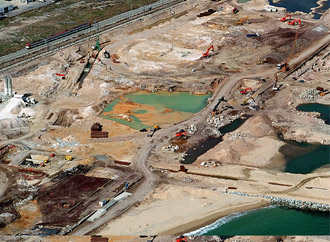Badalona Marina and Fishing Port
Description of the Environmental Measure
Problem detected:
Most of the residues from the excavation are black ashes and slag from burning pyrites and dust and purple soil. The rest consists of remains from the production of copper sulphate. The wastes contained highly polluting elements such as heavy metals and, to a lesser extent, sulphates. The most abundant heavy metals were copper, zinc, arsenic and lead. In prior studies before carrying out the work it was determined that there were some 45,000 m3 of soil to be decontaminated before transporting to authorised class II tips. By the end of the project, the measurement reached 60,000 m3 decontaminated.
Solutions adopted:
The activities were focused on the management of 45,000 m3 of class 2 and 3 wastes according to prior studies. This han dling consisted of excavating the soil, treating the waste and transporting it to an authorised tip.
The overall project involved excavating 720,000 m3 of earth of which 200,000 m3 were from dredging and excavation below the water table. The plan for the project was to use the sand from the excavation to regenerate the beaches next to the port.
The problem arose when, during the work, more polluted soil was found, so that at the end of the project, only 85,000 m3 of soil from the exterior dredging were used on the beach.
This had two important consequences: the excavation had to be carried out in enclosed areas to prevent the pollution of the marine environment, and it had to be placed in intermediate stockpiles to take samples of the soil every 500 tonnes and thus determine its destination - class I tip or beach.
Added to this problem was that of handling the polluted soil on the site without polluting the marine environment. It was necessary to excavate in closed areas so that the port was dredged to the 3.5 m level and at this level the material was still great effected by the surface pollution. Further, as excavation progressed, smaller areas of land were left for stockpiling and the work became more complicated.
The outer areas that could not be reached by land means were dredged using a similar process, forming intermediate stock piles from which samples were taken every 500 tonnes. This excavation caused an important increase in at the schedule for carrying out all the work but guaranteed a suitable destination for the resulting soil, minimising the tipping of soil and making the greatest possible use of the useful sand for regenerating the beaches.
Results:
The results were an increase of the volume of decontaminated soil over that initially forecast, the segregation of soil not suitable for regenerating the beaches and the maximum use of the usable volume, avoiding the risk of polluting these spaces.









